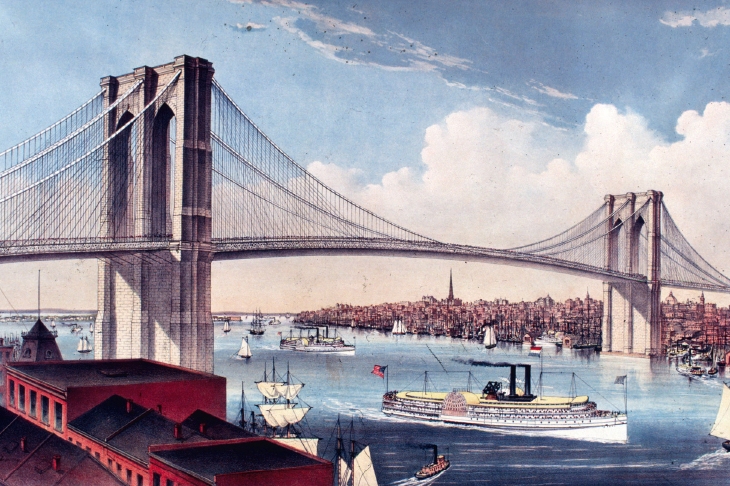Before Brooklyn exceeded it in cool, Manhattanites spoke dismissively of BNTs. These were the Bridge ‘n’ Tunnel folk, the out-of-towners who needed civil engineering to help them reach social nirvana. The ambitious critic Norman Podhoretz, a master of self-invention, was one such. His notorious Making It (1967) begins: ‘One of the longest journeys in the world is… from Brooklyn to Manhattan.’
But since 1883 the journey over the East River has only been 5,989 feet, although physical distance was not the measure that pained Podhoretz. That’s the total length of Washington Roebling’s Brooklyn Bridge, the first connection between the outer boroughs and the elite ‘New York’. It was, and remains, both symbol and structure of huge dimensions: long-span bridge-building was, in the late 19th century, a bravura expression of US expertise.
It is actually quite difficult to make an ugly bridge — think of Freyssinet, Eiffel, Brunel, Telford — although during Britain’s motorway-building era, the old Ministry of Works did its damnedest. A bridge is always a fine demonstration of form and function, but there is poetry too. Bridges connect places once separate, creating hitherto unseen vistas. Their conception requires a mixture of boldness and caution. Like all the best design, a good bridge contributes to both commerce and culture.
There have been other books about the Brooklyn Bridge, notably David McCullough’s The Great Bridge (1982), but Erica Wagner’s is rather a biography, almost a psychological biography, of its designer. Washington Roebling was the son of John, a German immigrant of exacting, even exigent, character who initiated what was originally the East River Bridge. When the older man died of tetanus following the amputation of his toes after a freakish site accident, Roebling junior took over, aged only 32. Besides its imaginative vision and sublime size, the Brooklyn Bridge has important technical novelties: instead of unreliable old iron chains, its vast, suspended span was made possible by the steel wire, patented in 1842, which had made the Roebling family rich.
Then there were the caissons. Wagner is specially good on caissons, peculiar to the art of the bridge designer. Basically, you begin an over-water bridge by sinking a box — wood in the case of Brooklyn — into the water and continue until it eventually hits bedrock. To facilitate the sinking, Roebling started building the masonry structure on top of it. Meanwhile, the caisson is pressurised so workmen can enter the hellish space and shovel out the muck. Many suffered from the bends and all must have been tolerant of claustrophobia. Progress was slow. Occasionally, Roebling resorted to blasting to speed things up. The mighty masonry towers of Brooklyn Bridge still rest on submerged caissons of southern yellow pine.
As a one-time literary editor of the Times, it’s curious that Wagner does not mention Hart Crane’s 1930 poem ‘The Bridge’, an ecstatic hymn to all things pontine with atmospheric photographs by his friend, Walker Evans. This was a year after the opening of New York’s Museum of Modern Art and techno-romanticism was dans le vent. ‘A rip-tooth of the sky’s acetylene’, Crane writes and, most often quoted : ‘And of the curveship lend a myth to God’. And to prove Ballard’s truth about mysterious alignments, Hart Crane lived at Columbia Heights in Brooklyn, the very same address as Washington Roebling. To both men, the bridge was a looming presence, both mechanical and metaphysical, but to Roebling it was something else besides: involved in decisive actions for the Union at Antietam and Gettysburg, he perhaps saw the bridge as a unifying symbol after a divisive Civil War.
As technical achievement, the Brooklyn Bridge reveals London’s Garden Bridge as an infantile frivolity. Quite correctly, Wagner bigs up Roebling’s heroism, commitment and physical bravery. She beautifully evokes how the bridge looks inevitable and permanent, but, is in fact, a nervous, living thing ‘instinct with motion’.
The mathematics involved were the rocket science of their day and Roebling’s proved infallible: 27 people died during construction, but no technical failure has caused a fatality since. Roebling’s design was six times stronger than even his most pessimistic calculations demanded: he said it might sag, but insisted it would never collapse.
Chief Engineer was made possible by the discovery of an unpublished memoir at Rutgers University and Wagner has mined it well. She tells the story with the thoroughness of Roebling’s calculations: the book is as robust in structure and fine in detail as the bridge itself and, like its subject, unlikely to be bettered. It is immaculately researched, meticulously written but exciting and evocative too.
The quality of any design may be judged by how readily it’s absorbed into popular iconography. Brooklyn Bridge soon achieved that, becoming a visual eponym for New York rivalled only by the Empire State Building; and that came 50 years later. Chief Engineer proves, if proof were needed, that in the modern age, technology usurped art’s role in the matter of beauty and the expression of shared yearnings. As Roebling senior explained in 1867: ‘As a great work of art… this structure will forever testify to the energy, enterprise & wealth of that community which shall secure its erection.’ Nice that it’s a literary editor who proves this engineering point.






Comments